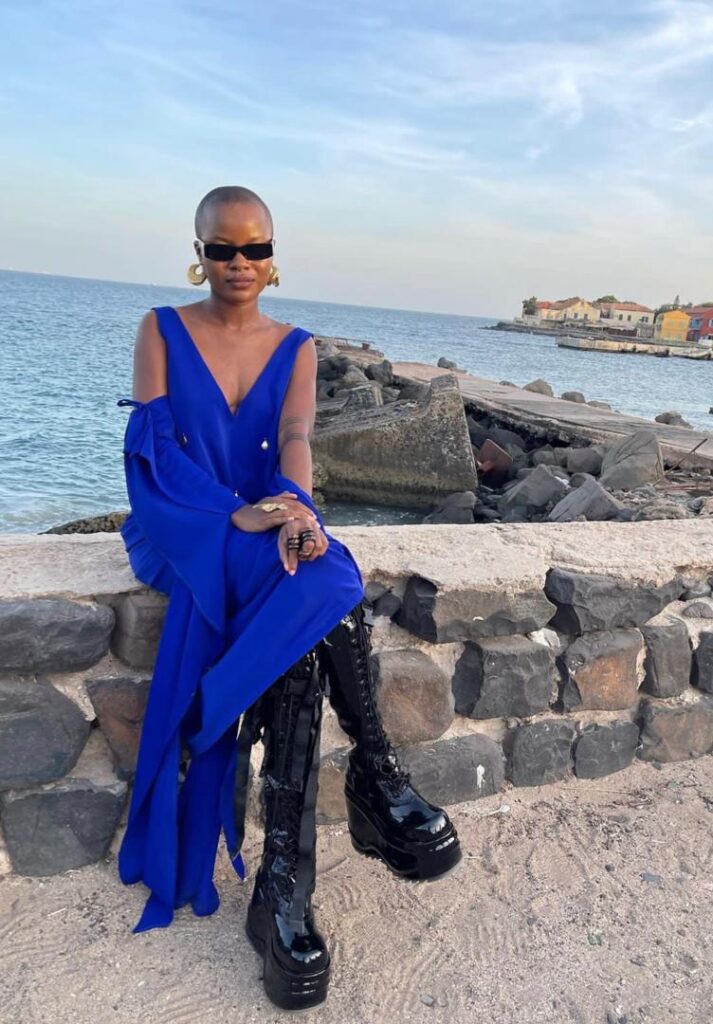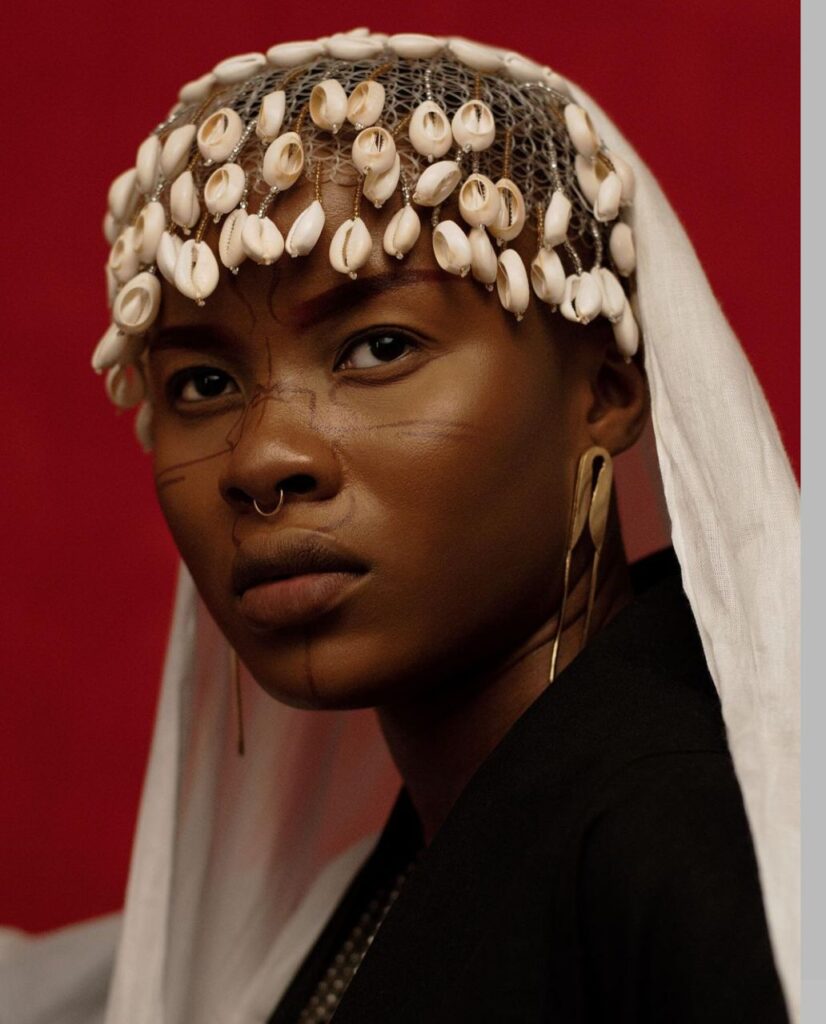Growing up as a young girl from the Dan tribe in Côte d’Ivoire, Lafalaise Dion was fascinated by the Tématé dancers whose head gears were regally adorned with cowries as they went about their graceful dances…
By Ijeoma Anastasia Ntada
Cowries, women, and spirituality
In July 2019, Beyoncés’s “Spirit” video was released. The project which gave adulation to African art, creativity and style, was one of a kind. Beyoncé pulled off the masterpiece with the help of several African artists. One of those artists was the Ivorian “Queen of Cowrie,” Dion Dewand Marcia Lafalaise, more popularly known as Lafalaise Dion, who was the mastermind behind every cowrie in the video, and of Beyoncé’s cowrie head piece.
Different people see cowries in different lights. Some see them as nothing but the pretty shells of tiny mollusks. Some see them as a memento of the times cowries were used as a means of trading in Africa. Then there are those who see them with aesthetic and spiritual eyes. This is the category that Dion belongs to. Who, then, is Lafalaise Dion, this Ivorian woman who makes cowries into perfection?
Growing up as a young girl from the Dan tribe in Côte d’Ivoire, Dion was fascinated by the Tématé dancers whose head gears were regally adorned with cowries as they went about their graceful dances. But she couldn’t participate in such dances as a lot of misconceptions and superstitions often trailed them.

“Misconceptions, superstition and my gran passing away drifted me away from my culture and curiosity for a while,” Dion disclosed in an interesting conversation I had with her.
As the young Dion grew older, she began to immerse herself in the culture of her people. It was around that time that she became fully awakened to her spirituality and style. Her longing and curiosity about cowries and the ways of the Dan/Yacouba people to which she proudly belongs would lead her to investigate further and eventually take up a career in journalism, investigating and curating stories about African spiritualities. Dion studied Journalism at the Institute of Science and Technology in Abidjan. Her passion for journalism is evident in her job as the content manager of ELLE Magazine, Côte d’Ivoire.
“My own spiritual journey was a turning point that led me to question my beliefs and to seek a deeper understanding of the world. As I connected with the divine feminine, Lafalaise Dion was born. Lafalaise Dion emerged from my desire to reconnect with my cultural roots, my spirituality, my inner magic, and the divine feminine. Everything we produce, every piece, work of art, project, or event, is rooted in our connection to the Divine Feminine,” Dion revealed during our conversation.
Lafalaise Dion crafted her very first head piece in 2018, a headdress set that she wore proudly in Accra during the celebration of the popular Street festival, Châle Wote. The creative process involved in making the headdress and the story embedded in it seduced many creatives who sought her designer skills for key collaborations.
The headdress which Dion originally made to promote her cultural identification and style would turn out to become the beginning of Dion’s career, the first piece of the Lafalaise Dion brand. Over time, the Dion brand has grown to become an international one that finds inspiration in the simple, yet graceful beauty of cowries. Since the phenomenal headdress of 2018, Dion has been collaborating with artists like Rossy de Palma, Novi Brown, Summer Walker, Ebonee Davis, Karefa Johnson, Jean-Baptiste Mondino, and many others.
Sometimes, one would wonder why, of all African materials, the Dion brand chooses majorly cowries to work with.
“The cowrie shell holds great significance in African culture, particularly in relation to the representation of women, creativity, and the divine feminine. It is a symbol of creation and the power of the feminine energy that brings forth life,” Dion enthused.
Beyond beauty and style, cowries are a lot more for women. Some African legends see cowrie shells as representatives of the protection of Yemaya, the ocean goddess. It is also seen as a symbol of fertility and successful deliveries. A close look at a cowrie shell shows a vulva-like opening. This opening is regarded as the elixir of life. This deep connection to the feminine is evident in Lafalaise Dion’s management. The brand is run and managed by women. While it incorporates men into its modeling, it is majorly a brand for women. Dion likes to describe the brand as one made in Africa for the world.
“Aesthetically, the cowrie shell is also a stunning and visually captivating natural element that has been used for centuries in various forms of artistic expression, from jewelry to clothing and beyond. Its smooth and intricate shape and pattern make it an attractive feature that can elevate any design.”

“The use of cowrie shells in African fashion and art is not only an acknowledgment of their inherent beauty but also a way to honor their spiritual and cultural significance. This is why the cowrie shell is the centerpiece, the omnipresent element of all my creations; it equally represents the identity of my brand,” Dion disclosed.
A call towards home
For Dion who draws inspiration from home and her roots, the cowrie shell holds a lot of meaning. Embedding cowries into her art is like travelling back in time to gaze at the Tématé dancers who wore cowries, filled her childhood with fun, and made her fall in love with the beauty of cowries. Also, the Dan people of Côte d’Ivoire use cowries to communicate with the spirit world. For Dion, cowries bear a great deal of spiritual essence.
“The cowries represent me in my entirety. By this, I mean that they are my Yacouba heritage, my belonging to the beautiful African continent, my spirituality, and my inspiration. They have guided me on the path of my passions: fashion and styling; they have steered me to discover myself through the fascination I have for them and above all, to continually open my mind through the research they lead me to do. My creations, for me, are little poems dedicated to my ancestors to thank them for the heritage, pride, knowledge, and love they bequeathed me. They also tell the story of a grandma transmitting her experience of the world and society to her granddaughter.”
Preserving creativity through “Cowrying”
The Lafalaise Dion brand is beyond creating cowrie pieces; it is also about preservation of African culture and its wealth of tradition, from sourcing for production materials from local artisans to using methods unique to Africa.
It is not uncommon to see Africa misrepresented in film and art, especially those made outside of Africa. This is a gap that the Dion brand wishes to bridge by ensuring that her work connects mainly with people of African descent looking for reconnection with their ancestral heritage and initiating cultural re-appropriation by celebrating African cultures’ richness and uniqueness.
“We see ourselves as a bridge between the past and present, connecting the African Diaspora with their ancestral heritage.”
Despite the exponential growth of the Dion brand, it is not without its struggles.

“One of the primary challenges the African fashion Industry faces is limited access to finances. Brands of the African continent face significant difficulties in obtaining capital to expand and consolidate their businesses. Not only are credit facilities scarce, but in many of our countries, capital comes at a high cost. An effective remedy will be to have local governments and private-sector organizations working together in all transparency, to provide African fashion brands with access to affordable capital.”
The African fashion industry will grow in leaps and bounds if every individual and body come together and contribute to its growth. The industry is too creative and amazing to be ignored.
Lafalaise Dion admonishes every creative out there to dream big dreams, to listen to the signs sent by the universe, trust in their goals, and never back down from attaining them. If there’s one thing to learn from the Dion brand, it is strength and tenacity. “Dream as long and as big as your imagination can allow you to.”
Ijeoma Anastasia Ntada writes and reads poetry, fiction and nonfiction. She has a couple of poems published in the Love Anthology, The Ducor Review, Visual Verse, Praxis Review and other places. Ijeoma is also a photography enthusiast. She takes beautiful photographs and makes them art. When Ijeoma isn’t studying to become a Laboratory Scientist, you’ll find her talking about Afro Hair, femininity, and embracing all of her girlhood.




Simply Beautiful!
It’s really fascinating how something that little could change someone , cowries a literarily small LOL.
It’s time to start listening to the signs the universe is bringing at us.
The little thing is changing the African fashion industry
It’s really fascinating how something little could change someone.
Cowries are literarily small LOL.
It’s time to start listening to the signs the universe is bringing at us.
These ornaments are a symbol of one’s creativity, status, allegiance and honour to one’s African tribal roots. Wearing African clothing and fashion is also an exceptional way for many to honour and commemorate their heritage and the beauty of their homeland.
Never knew that cowries looked like a vulva I’m just knowing.
These ornaments are a symbol of one’s creativity, status, allegiance and honour to one’s African tribal roots. Wearing African clothing and fashion is also an exceptional way for many to honour and commemorate their heritage and the beauty of their homeland.